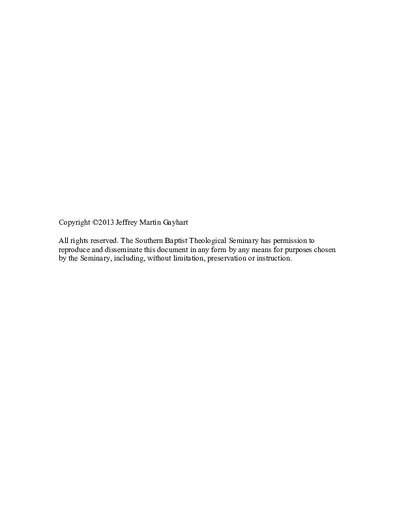| dc.description.abstract | ABSTRACT
THE EFFECTIVENESS OF THE HANDS ON PROGRAM
IN ATTAINING THE STATED GOALS OF THE
INTERNATIONAL MISSION BOARD:
A QUANTITATIVE STUDY
Jeffrey Martin Gayhart, Ph.D.
The Southern Baptist Theological Seminary, 2013
Chair: Dr. George H. Martin
This dissertation examines the effectiveness of the International Mission Board's Hands On program in reaching stated goals. Chapter 1 introduces the research question by examining the current state of short-term missions (STM) and the Foreign Mission Board/International Mission Board's (FMB/IMB) methodological embrace of STM. This chapter introduces a particular short-term mission (STM) opportunity offered by the IMB, called Hands On. The research questions are addressed by a historical study and by a quantitative study of the effectiveness of the Hands On program.
Chapter 2 is a more in depth historical study of the Southern Baptist Convention (SBC), the history of the FMB/IMB and its embrace of new methodologies, particularly STM. The chapter notes the FMB's initial use of college students for STM assignments, which blossomed into the Journeyman program. The chapter concludes with the FMB's adoption of Bold Mission Thrust as impetus for a more robust student mission strategy, including Hands On.
Chapter 3 is an additional historical sketch for this study that reviews the history of STM and student missions. This chapter explains how the early histories of the SBC and student missions/STM movement parallel one another chronologically but not methodologically. The student missions/STM movement is a historical phenomenon that both informs the IMB's strategy and benefits from the IMB's methodological embrace. Also, this chapter surveys technological and sociological advances that opened the world to shorter-term missionaries.
The final two chapters focus on the results, analysis, and answers to the research problem. Chapter 4 includes the results and findings of the quantitative survey. In addition, this chapter explains the data analysis method of structural equation modeling (SEM), which is used to analyze multivariate data.
Chapter 5 discusses presented resolutions (or lack thereof) to the research problems introduced in Chapter 1. In addition, this chapter includes recommendations for changes in the Hands On program. Finally, this chapter highlights some potential areas for further research. | en_US |

